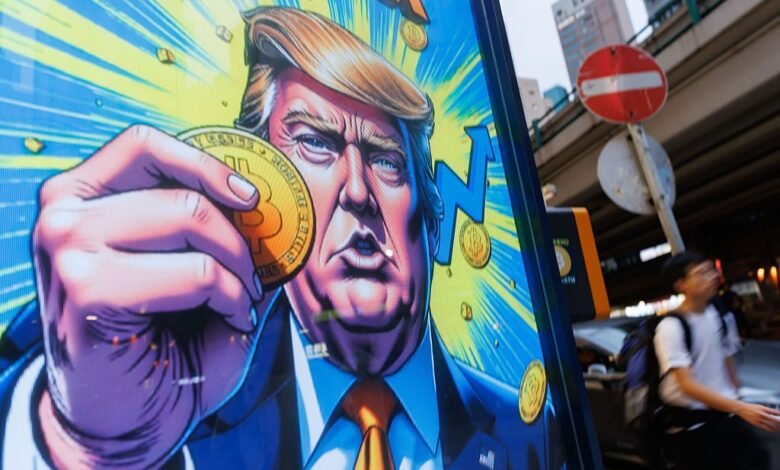The fall of the crypto-oligarchs

Crypto should be soaring right now. All the conditions are in place for a spectacular rally: abundant money supply, easy financial conditions, and a US administration which is actively pushing crypto with favourable deregulation and the creation of a strategic reserve to boost its price. President Trump has promised to turn the US into “the crypto capital of the planet” — and he appears to mean it.
And yet, after a rally to an all-time peak at the start of October, Bitcoin has fallen hard, shedding some 15% of its value in just the last two weeks. Sharp volatility isn’t unusual in crypto but this pullback has happened at a time when the broader market has either held steady or kept rallying. G7 markets are off by 1 or 2% but emerging markets remain buoyant. Meanwhile, gold — the heavier, klunkier version of the “digital gold” that Bitcoin purports to be — is soaring, rising 7% over the same two-week period, and taking its gain since the new year to an eye-popping 60%.
It could be that Bitcoin’s seemingly relentless upward climb will resume in the coming days and that all this will turn out to be much ado about nothing. But the past fortnight could also be a harbinger of its eventual demise. The Bitcoin oligarchs may find it eventually explodes in their hands.
When Bitcoin was created amid the angry fallout from the 2008 bank bailouts, it was designed to take money out of the hands of the bankers and oligarchs who dominated finance and hand it to the people, offering them an alternative system in which to conduct their business. Its political purpose was buried in the very first block of Bitcoin mined, which contained the line: “The Times 03/Jan/2009 Chancellor on brink of second bailout for banks.” The digital currency was built upon the novel blockchain technology, which substituted a digital chain for the ledgers used by banks to record transactions, enabling users to thereby circumvent the banks. By fixing its supply at a maximum of 21 million, Bitcoin’s creators ensured that unlike the fiat currency managed by central banks, it could not be devalued: the more money central banks printed to re-capitalise the collapsed financial system, the more valuable Bitcoin would become.
Yet the revolution in finance it was meant to bring about never took place. True, for those rebels who got in early, Bitcoin has certainly paid off handsomely. Worth mere pennies at its creation, it surpassed the $10,000 mark by the end of its first decade and is worth over $100,000 today.
“The Bitcoin oligarchs may find it eventually explodes in their hands.”
Beyond that, though, not much remains of Bitcoin’s early, idealistic vision. There was admittedly some democratisation, as over 50 million people bought Bitcoin — more if one includes people who’ve bought shares in funds that own Bitcoin. Yet it never managed to become an actual currency, being too cumbersome and volatile to be useful as a medium of exchange.
More tellingly, the crypto universe is now dominated by a handful of oligarchs managing large funds and “Bitcoin treasuries” who, by forging close ties with the Trump administration, have used state patronage to boost their asset values, much as the banks did in 2008. Trump and his family have themselves reportedly made $1 billion off their crypto creations. And with investment banks now offering crypto products to their clients, the formal takeover of crypto seems complete. This isn’t the radical, decentralised financial system we were promised.
Rather than treat crypto as an alternative financial system, these “crypto-garchs” have turned it into a speculative asset, whose price they manipulate through Bitcoin treasuries — large funds whose purpose is to take Bitcoin off the market so as to further boost its price.
The biggest of these funds is MicroStrategy (which, though recently re-branded as Strategy, still goes by the stock-ticker label of MSTR). MSTR was originally a software company founded in 1989 by American entrepreneur Michael Saylor. After a history of setbacks and repeated run-ins with regulatory and tax authorities, Saylor finally found his pot of gold in 2020. At that time, as central banks responded to the Covid crash by flooding the market with money, Bitcoin rallied strongly. Saylor used his company’s cash to buy a relatively small stash of Bitcoin. When it rose in value, his plan took flight.
The business model was simple: by buying Bitcoin in large quantities, MSTR helped bid up its price. As the value of its holdings rose, so did the company share price. That meant MSTR could both sell new shares and raise new debt, further boosting its holdings. And on it went for the next four years in a virtuous — to the company and its shareholders — upward spiral. The value of MSTR’s Bitcoin holdings rose from $250 million in 2020 to over $40 billion this year, while MSTR’s share price shot up from $12 to over $400 in the same time span. Other funds soon followed suit, and today the vast majority of Bitcoin are held by just 2% of its owners, with a few dozen of them alone controlling a fifth.
Taking over the market in this way gave the crypto-garchs both economic and political leverage: economic, in that by removing Bitcoin from circulation they reduced the market’s liquidity, which amplified the impact of their further purchases, since they were now bidding for a smaller pool of Bitcoin. And political, in that they now had deep pockets with which to influence politicians in the 2024 election.
With the Biden administration taking a sceptical view of crypto, the crypto-garchs turned to Donald Trump. Although originally a crypto-sceptic, calling it a scam as recently as 2021, Trump saw the opportunity in forging ties with an industry that was then out of favour. The industry donated more than $130 million to election campaigns, with an eye on displacing crypto-sceptics and supporting their backers, led by Trump. In return, Trump promised to lift regulation and promote the industry.
After Trump won the election, he came good on his pledges. He appointed big crypto-donors such as Howard Lutnick to his Cabinet, ended investigations into firms such as Gemini, which is owned by the same Winklevoss twins who’d donated $3 million to his political action committee, and withdrew a lawsuit against Coinbase, which together with some of its owners had contributed some $16 million to Trump’s campaign funds. After announcing his plan to create a strategic Bitcoin reserve, Trump hosted several crypto-garchs at the White House, Michael Saylor among them, to discuss its implementation.
All this paid big dividends to MSTR. In the month after Trump’s election victory, the price of Bitcoin rose over 50%, which enabled Saylor to return to the market with a major share flotation. MSTR raised $21 billion in share sales, giving it a powerful armoury to juice the Bitcoin price further.
But for all its lucre, there was an obvious flaw in this plan. Given their dominance of the market, that amplification of the impact of their purchases worked both ways. Given the relatively low volume of Bitcoin trades on any given day, even a small sale will sharply raise the supply — MSTR alone owns more Bitcoin than trade daily, so even a small liquidation of its portfolio would cause prices to fall sharply. If the crypto-garchs sold in volume to cover their debts or meet expenses, they’d crash the market. In for a penny, they were now in for a pound.
The crypto-garchs may now be holding a time-bomb. If MSTR is anything to go by, the money may be drying up: of the $21 billion the company raised last year, MSTR blew it all in the following three months. Since then, the company has struggled to raise new share capital.
The company isn’t under any imminent pressure. The debt MSTR raised to buy Bitcoin doesn’t come due for another two years, and having purchased its stash of Bitcoin for an average price of around $74,000, it’s still nearly 50% up. But if Bitcoin doesn’t resume rising, MSTR will struggle to raise more capital. In the meantime, its purchases of Bitcoin are diminishing, and failing — for now, at least — to bolster the price. MSTR is still buying Bitcoin at a weekly rate, but it is paying above market rates and its purchases have grown much smaller. Amid this, smaller Bitcoin treasuries are now starting to go to the wall.
This may explain why the gold market is booming as Bitcoin suffers. It appears that investors believe that if the only thing left of Bitcoin is a digital equivalent to gold — a store of value with limited fungibility — they might as well stick with the original. After all, humans have turned to gold amid social and economic crises for millennia, but have only held Bitcoin for a few years. If they sense a major crash might be coming, atavism may lead them back into the fold of what they know to work.
In the short term, given all the favourable tailwinds, it seems more likely than not that Bitcoin will resume its rise. But the events of the last two weeks may foreshadow Bitcoin’s eventual endgame: the spark that lights a fire under markets. Bitcoin has now spread so deeply into the formal system that a major crash would likely force other liquidations as fund managers looked to cover their losses, possibly starting a chain-reaction through markets. And while oligarchs in 2008 had every reason to expect the government would bail them out, this time might be different. The proportionate size of US debt has doubled in the intervening years, and bailing out the Bitcoiners would likely send bond yields soaring. The crypto-garchs may thus not find the shelter they’d expect in a storm.
If this ends up toppling a few oligarchs, Bitcoin’s original creators may feel their vision came true after all.






